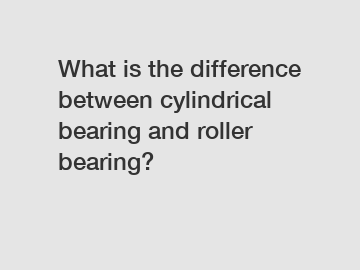What is the difference between cylindrical bearing and roller bearing?
Bearings are a critical component of various mechanical systems, enabling smooth rotation and reducing friction between moving parts. Two widely used types of bearings are cylindrical bearings and roller bearings. While they both serve the common purpose of facilitating rotational motion, they possess distinct characteristics that make them suitable for specific applications. In this blog, we will delve into the intricate differences between these two types of bearings, shedding light on their unique features and advantages.
1. Understanding Cylindrical Bearings:
Cylindrical bearings, as the name suggests, consist of cylindrical-shaped rolling elements. Typically, these rolling elements are in the form of cylinders with a length-to-diameter ratio close to 1. They are designed to operate under heavy loads, making them ideal for applications with high radial load requirements. The rolling elements of cylindrical bearings maintain contact with the raceway at all times, distributing the load over a relatively large surface area. This design mitigates the risk of localized stress concentration and increases load-carrying capacity.

2. Exploring Roller Bearings:
Roller bearings, on the other hand, employ cylindrical, tapered, or spherical rolling elements called rollers. These rollers have a greater length-to-diameter ratio than cylindrical bearings, allowing them to withstand higher radial and axial loads. Roller bearings are commonly found in heavy industrial machinery, such as conveyors, rock crushers, and gearboxes. The longer contact areas between the rollers and the raceway enhance load distribution capabilities and reduce the risk of premature wear due to high stress concentrations.
3. Comparing Load Capacities:
One significant difference between cylindrical and roller bearings lies in their load-carrying capacities. Due to their larger contact area, cylindrical bearings are better suited for handling heavy radial loads. This makes them suitable for applications with predominantly radial forces, such as engines, turbines, and electric motors. On the other hand, roller bearings, with their elongated rolling elements, exhibit superior axial load capacities, making them the preferred choice where both radial and axial loads are present.
4. Considering Speed and Friction:
In terms of rotational speed, cylindrical bearings tend to outperform roller bearings. This is because cylindrical bearings have a smaller surface area in contact with the raceway, reducing friction and allowing for higher rotational speeds. Conversely, roller bearings provide more stability and increased contact area, resulting in improved load distribution even at high speeds. Therefore, the application requirements and desired performance will determine which type of bearing is better suited.
5. Examining Rigidity and Alignment:
Cylindrical bearings offer excellent rigidity and alignment capabilities, making them reliable in applications with strict mounting requirements. Their rigid structure ensures minimal deformations even under heavy loads, maintaining precise shaft alignment. Roller bearings, while generally less rigid, compensate for this with their self-aligning capabilities. They can automatically adjust to minor misalignments, reducing the risks associated with misaligned rotating elements.
6. Considering Lubrication and Maintenance:
Both cylindrical and roller bearings demand regular lubrication to ensure optimal performance and longevity. However, cylindrical bearings typically have lower lubrication requirements due to their smaller contact area, which reduces friction and heat generation. Conversely, roller bearings require more lubrication to maintain the efficiency of their extended contact surfaces. Adequate lubrication and regular maintenance schedules are crucial for preventing premature wear and ensuring the longevity of either type of bearing.
Conclusion:
In summary, while cylindrical bearings and roller bearings share the common goal of facilitating rotational motion, they possess distinct characteristics that make them better suited for specific applications. Cylindrical bearings excel in handling heavy radial loads and offer excellent rigidity and alignment capabilities. Roller bearings, on the other hand, have superior axial load capacities, increased load distribution, and self-aligning capabilities. Understanding these differences is essential when choosing the right bearing for a particular mechanical system, ensuring optimal performance, and prolonging the lifespan of the machinery.
For more information, please visit Heavy-Duty Flanged Roller Bearings for Coal Crushers, China Ball Bearings, China Top Quality Bearing.


